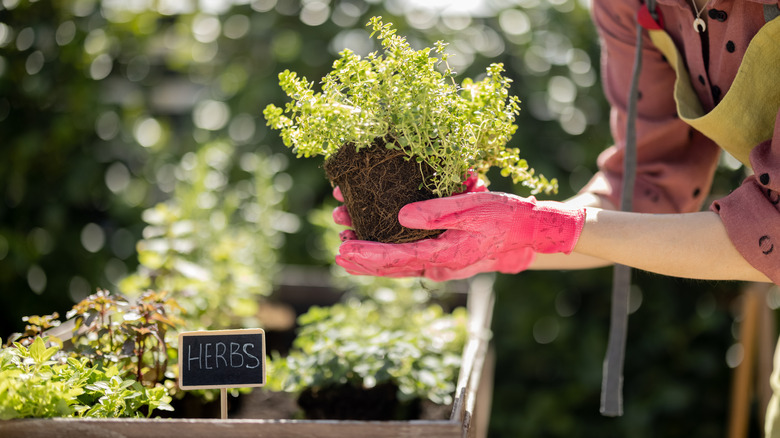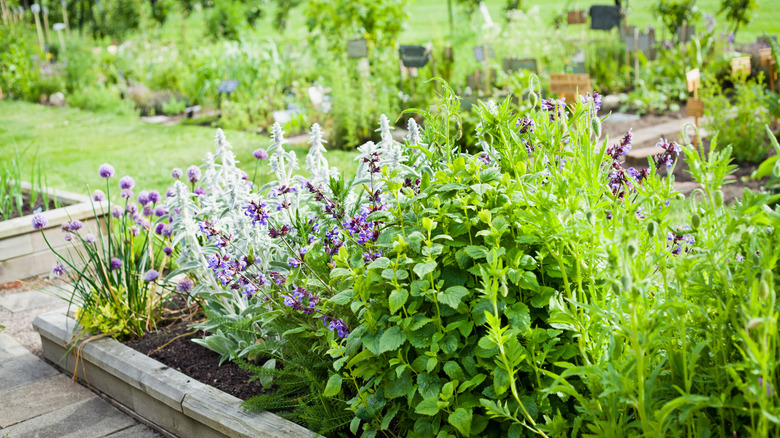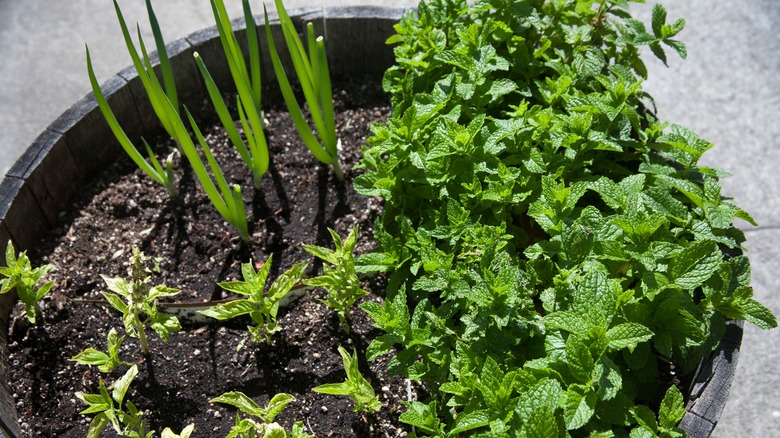Plant These Drought-Tolerant Herbs Together For A More Successful Herb Garden
Cultivating an herb garden, whether indoor or outdoor, is great for gardeners and home chefs alike. They provide a convenient and sustainable supply of fresh herbs, enhancing the flavor and nutritional value of meals. Moreover, tending to the garden fosters a sense of mindfulness and relaxation. Growing your own herb garden also encourages eco-friendly practices by decreasing reliance on store-bought, packaged herbs, which tend to be expensive for a small supply. So if you're thinking of starting your own herb garden, first consider which plants you'd like to grow based on how frequently you use them. Another easily overlooked yet crucial step is to consider the vessels in which you will grow your herbs and how often they'll need water.
If you decide to grow your herbs inside, planting them in solo containers is likely the best approach, as window sills, a sunny place that herbs love, often don't allow for larger containers. Though if you choose to pot your herbs together, whether they are inside or outside, it's best to consider the watering needs of your plant selections before potting them ,as many herbs fall into the categories of drought-tolerant or heavy drinkers. Drought-tolerant herbs like rosemary, for example, should not be planted in the same pot as basil, as the latter is a heavy drinker.
Companion planting for drought-tolerant herbs
When creating a drought-tolerant herb garden, it's essential to select herbs that share similar water requirements and thrive in less moist conditions. Consider the following herbs, as they tend to thrive in more arid conditions, whether inside or in a backyard garden. Rosemary and thyme are resilient herbs that prefer well-drained soil and minimal watering once established. Both oregano and marjoram are hardy and need occasional watering during dry spells. Lastly, lavender, sage, and bay laurel only require watering during extended dry periods, but all do appreciate well-draining soil.
When it comes to watering your drought-tolerant herb garden, less is usually more. Allow the soil to dry out between waterings to encourage the plants' deep root growth and water storage capacity. In general, watering once every seven to ten days is sufficient for established herbs. However, this may vary depending on your climate, soil type, and specific herbs planted. Watch for signs that your drought-tolerant herbs need watering. If the leaves appear droopy and lackluster, it's a sign that the plant is thirsty. Check the soil's moisture level by inserting your finger about an inch deep into the soil. If it feels dry, it's time to water. Look out for brown or curling leaves, as these indicate that your herbs are thirsty. By companion planting drought-tolerant herbs and adopting appropriate watering practices, you can enjoy a thriving and low-maintenance herb garden even in dry conditions.
Companion planting for heavy drinking herbs
Alternatively, there are a number of herbs that enjoy more frequent watering and should be planted together to benefit from more consistent soakings. To start, basil loves moisture and should be consistently watered. Like tomatoes, they will wilt quickly without water, so planting them side by side is advantageous and can even improve the taste of your tomatoes. Additionally, mint thrives in moist soil and can even tolerate some shade. Do be careful if you plant mint alongside other herbs, though, because it is invasive and can overtake your garden. Finally, cilantro, chives, and parsley are great companion plants that enjoy regular watering and can be planted together.
Watering your herbs will depend on a number of factors, such as climate, soil type, and container size. As a general guideline, water the heavy-drinking herbs when the top inch of soil feels dry to the touch. In most cases, frequent watering for these herbs means providing moisture once every two to three days, but this may vary depending on environmental conditions. If you notice the leaves on your herbs turning yellow, it may be a sign that you have overwatered them, so try adjusting your hydration schedule. Nevertheless, by planting herbs with similar watering needs together and paying attention to these watering signs, you can ensure that your water-loving herbs flourish and provide you with a bountiful harvest.


